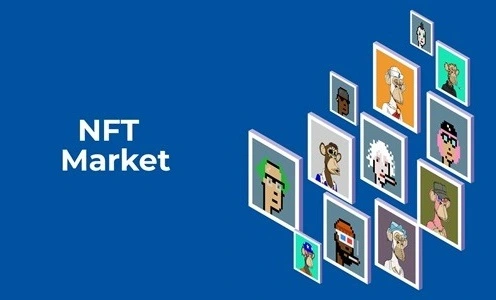The NFT (Non-Fungible Token) market has gained immense popularity in recent years. NFTs, which are based on blockchain technology, are digital assets representing uniqueness and ownership of virtual goods such as artwork, music, videos, and virtual real estate. In this article, we will delve deeply into the NFT market, explain how it works, present use cases and statistics, and discuss the advantages and disadvantages of this emerging technology.

Introduction to the NFT Market
NFTs first gained recognition in 2017 when the blockchain-based game CryptoKitties allowed players to buy, sell, and breed virtual cats. However, the market truly exploded in 2021 when digital artworks and collectibles were sold for millions of dollars. NFTs quickly became a new and exciting way to create and trade digital ownership.
According to a report by DappRadar, NFT sales volume surpassed $23 billion in 2021, underscoring the increasing acceptance and growing value of this market. Well-known auction houses like Christie’s and Sotheby’s began hosting NFT auctions, and companies from various industries, ranging from sports to fashion, entered the NFT space.
Despite the hype, the NFT market presents both opportunities and risks. In this guide, we will explore the basics of NFTs, their market structure, and their impact on various industries.
What is an NFT?
Definition and Functionality
NFT stands for “Non-Fungible Token.” Unlike fungible tokens such as Bitcoin or Ethereum, which are interchangeable with one another, each NFT is unique and cannot be replaced by another token. NFTs are stored on blockchain platforms such as Ethereum, and every transaction or ownership transfer is recorded there permanently and transparently.
Key characteristics of NFTs include:
- Uniqueness: Each NFT has its own metadata, distinguishing it from other NFTs.
- Indivisibility: NFTs cannot be divided into smaller units like cryptocurrencies can.
- Proof of Ownership: NFTs provide a clear proof of ownership for a digital asset.
Technological Foundations
Most NFTs are based on the Ethereum blockchain and use the ERC-721 token standard, which allows for the representation of unique assets. However, other blockchains, such as Flow and Binance Smart Chain, are also increasingly used for creating and trading NFTs.
To create an NFT, a process known as “minting,” artists or developers upload a digital work onto an NFT platform. This platform then registers the token on the blockchain. Once the token is created, it can be sold or traded on marketplaces.
Applications of NFTs
Digital Art
The most well-known use case for NFTs is the trading of digital art. Artists can sell their works as NFTs, thereby increasing the value of their digital creations. One famous example is the artwork “Everydays: The First 5000 Days” by the artist Beeple, which was auctioned at Christie’s in March 2021 for $69 million.
Virtual Worlds and Real Estate
In virtual worlds like Decentraland or The Sandbox, users can buy NFTs to own and trade virtual land. These virtual properties have real financial value and offer users the ability to build virtual structures or earn income through rent.
Collectibles and Sports Memorabilia
NFTs have also revolutionized the world of collectibles, particularly in sports. Platforms like NBA Top Shot allow users to buy and trade digital moments from basketball games. These collectibles, existing in NFT form, can be traded and sold on marketplaces.
Pros and Cons of the NFT Market
Advantages
- Creation of Digital Scarcity: NFTs make digital goods unique and limited in availability, increasing the value of artwork and collectibles.
- Direct Connection Between Artists and Buyers: Artists can sell NFTs directly to their followers without intermediaries like galleries or auction houses.
- Proof of Ownership: The blockchain offers an immutable and transparent record of NFT ownership.
Disadvantages
- High Environmental Costs: Minting NFTs requires a lot of energy, raising concerns about their environmental sustainability.
- Market Volatility: The NFT market is extremely volatile, and the value of NFTs can fluctuate significantly.
- Legal Uncertainty: There are still legal gray areas regarding copyright and intellectual property rights for NFTs.
The Future of the NFT Market
The NFT market has enormous potential, but how the technology and regulations will evolve remains to be seen. Many experts believe that NFTs could be used in more areas in the future, such as real estate, music rights, and even physical assets.
As more companies and artists recognize the possibilities of NFTs, they may play an even larger role in the coming years. However, challenges such as sustainability and the legal framework still need to be addressed.
Frequently Asked Questions (FAQ)
1. What is an NFT?
Ans : An NFT (Non-Fungible Token) is a unique digital asset stored on a blockchain, representing ownership rights over digital goods such as art, music, or collectibles.
2. How do I buy an NFT?
Ans : NFTs can be purchased on various marketplaces like OpenSea, Rarible, or Foundation. To buy an NFT, you will need a cryptocurrency like Ethereum and a digital wallet.
3. How does NFT minting work?
Ans : Minting is the process by which a digital asset is turned into an NFT and stored on the blockchain. This is usually done through specialized NFT platforms.
4. Are NFTs a good investment?
Ans : Investing in NFTs can be profitable, but it also carries risks. The market is volatile, and not every NFT will increase in value.
5. Why are some NFTs so expensive?
Ans : The value of an NFT depends on its uniqueness, the artist or creator, demand, and perceived cultural or emotional significance.
6. Are NFTs environmentally friendly?
Ans : The creation and trading of NFTs on certain blockchains, like Ethereum, consume a lot of energy, raising concerns about their environmental impact. However, efforts are being made to find more eco-friendly solutions.
7. What is the difference between fungible and non-fungible tokens?
Ans : Fungible tokens, like Bitcoin, are interchangeable, meaning each token holds the same value. Non-fungible tokens (NFTs) are unique and hold different values.
8. Can I sell an NFT?
Ans : Yes, NFTs can be traded and sold on marketplaces. The value depends on supply and demand in the market.
9. Which blockchain is used for NFTs?
Ans : Most NFTs are based on the Ethereum blockchain, but other blockchains like Flow and Binance Smart Chain are also increasingly used.
10. Are there risks in buying NFTs?
Ans : Yes, the NFT market is volatile and speculative. There is a risk that the value of an NFT may decrease or that legal issues regarding ownership or copyright may arise.
Conclusion
The NFT market offers exciting opportunities for artists, collectors, and investors. Although the hype around NFTs has grown significantly in recent years, the market presents both opportunities and risks. As with any investment, it’s important to conduct thorough research and understand the potential pros and cons before investing in NFTs. With the continued development of technology and the introduction of new applications, the NFT market could become even more significant in the coming years.
For more information and to dive deeper into the world of NFTs, visit Immediate Zenith to learn more about the latest developments in digital assets.

